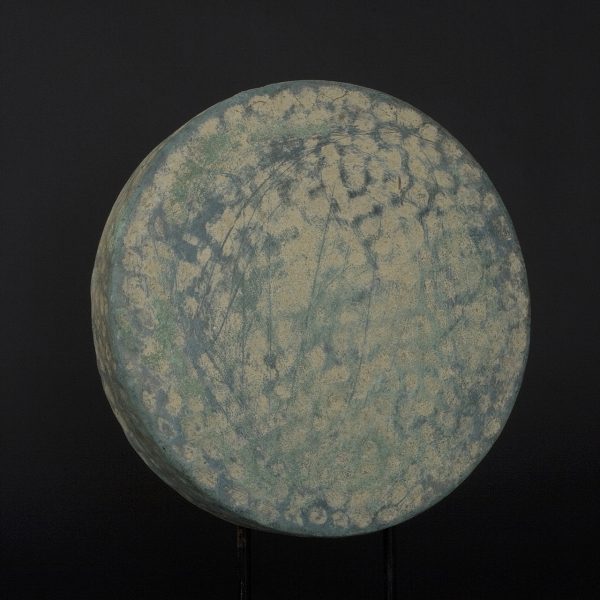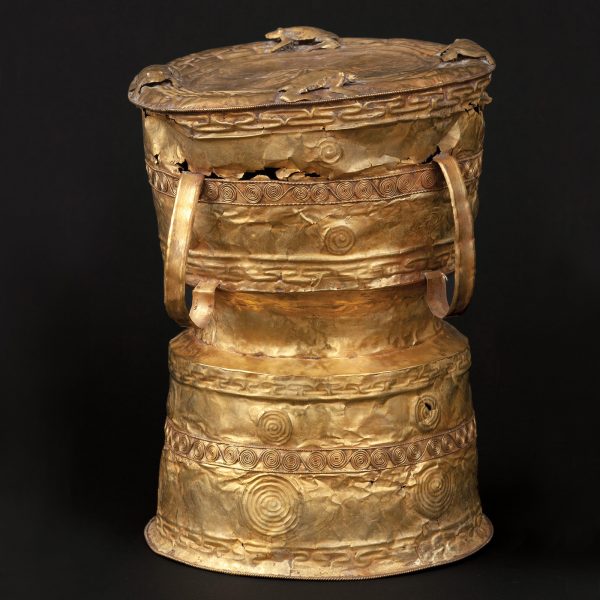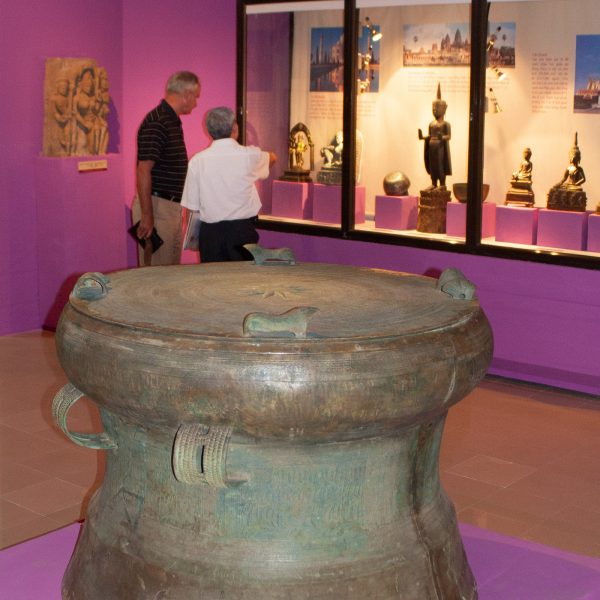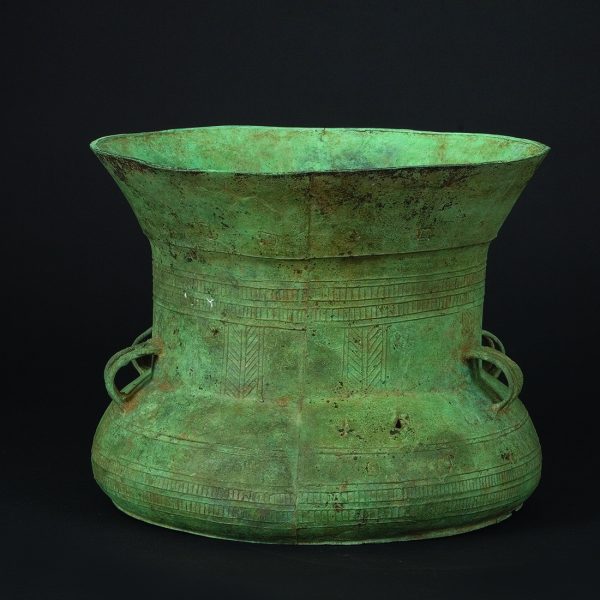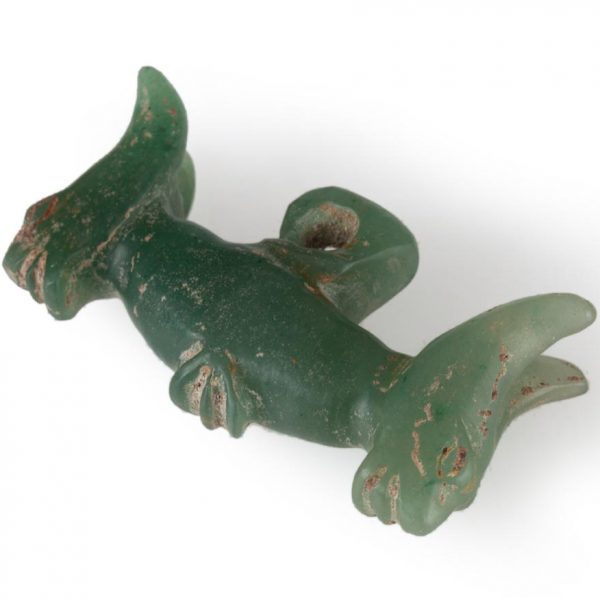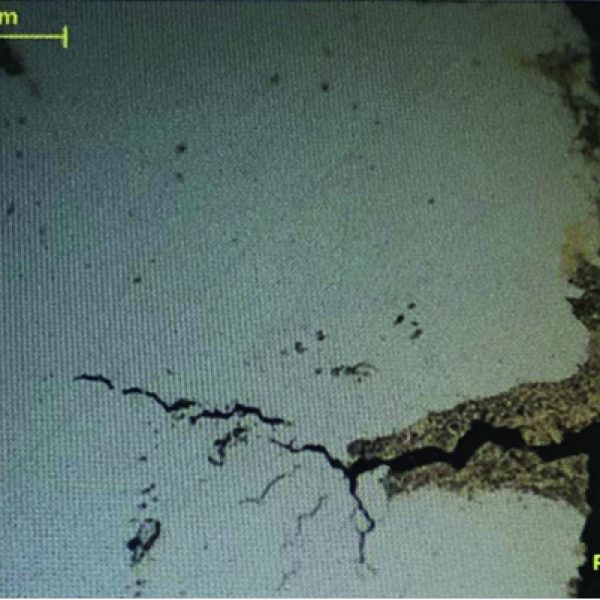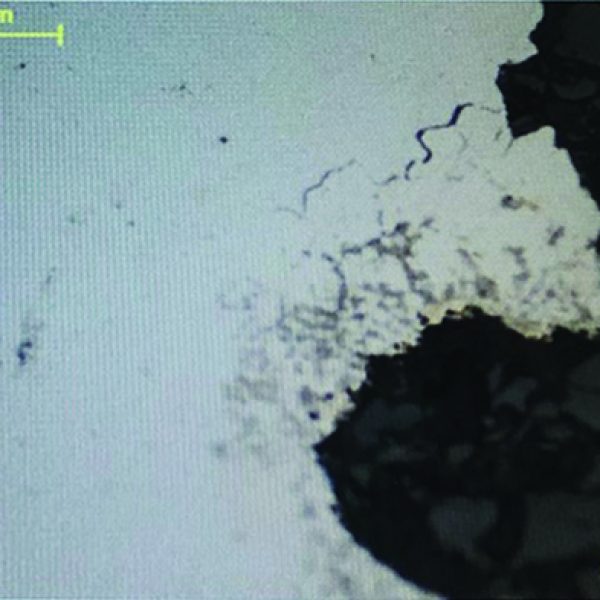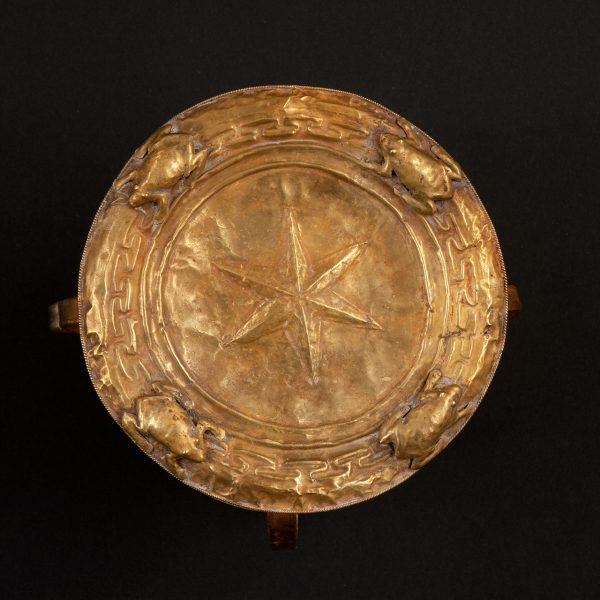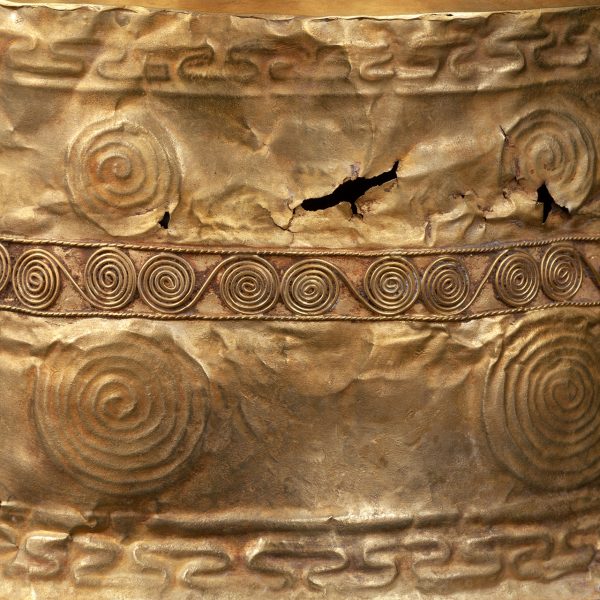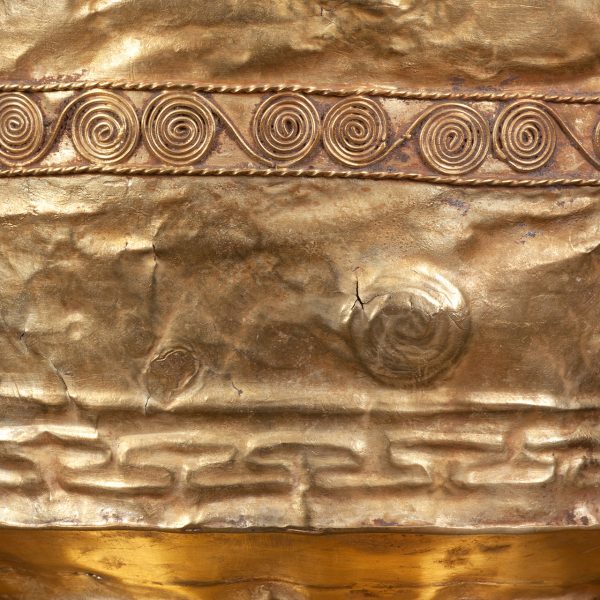Volume 1, Issue 2, May-June 2020.
The Dong Son Ritual Gold Drum
by Peter Northover, Dr. Zsuzsanna Renner and Jean-François Hubert
Dong Son Culture
The Dong Son Culture is an important prehistoric Indo-Chinese culture. It was named after the village in northern Vietnam where many of its remains have been found. The Dong Son site shows that bronze culture was introduced into Indochina from the north (China), probably around 300 BC, the date of the earliest Dong Son remains. Dong Son was not solely a bronze culture; its people also used iron implements and Chinese cultural artifacts. Nevertheless, their bronze work, especially their production of bronze ritual drums, was of a high order.
The Dong Son were seafaring people who apparently travelled and traded throughout Southeast Asia. They also cultivated rice and are credited with originating the process of changing the Red River delta area into a great rice-growing region. The Dong Son Culture, transformed by further Chinese and then Indian influence, became the basis of the general civilization of the region.
Dong Son Drums
Bronze ritual drums are characteristic objects of the Bronze-Age Don Son culture and were later used across the entire region from Southern China to the Indonesian Archipelago until the end of the 19th century.
A drum made of gold stands out as a particularly rare item. According to Dr. Franz Heger’s classification, described in his pioneer study of bronze drums, Alte Metalltrommeln aus Südost Asien (Leipzig, 1902), this drum has been classified as a Type I drum.
It is decorated with a star on the top—symbol of the sun, frogs set along the edge and spiral motifs on the cylinder. Frogs appear at each of four ninety-degree angles around the perimeter of the tympanum. Like most of the animal motifs depicted on frog drums, they face anti-clock-wise and appear to be following each other. They are placed astride the last set of concentric circles with their left feet in the last geometric band and the right feet in the blank band. They are quite plain with protruding eyes, pointed noses, broad waist and spreading haunches. The backbone is slightly raised. Frogs and other species of aquatic life represented on other drums may refer to watery biosphere, rains and agricultural fertility, this why these drums have become associated with rain magic. In addition to its ritual function, however the golden drum as a valuable asset and must have been a significant indicator of rank and a treasured item from the heritage of its one-time owner.
The sophisticated Bronze-Age Dong Son Culture-famous for its bronze drums-thrived in the Hong (Red) River valley from the seventh century BC to the second century AD. The Dong Son culture produced a wealth of bronze items, including tools, vessels, ornaments, weapons, arrowheads, axes, and bells, as well as ceramics and beads. The most impressive group of objects made was large, decorated gongs, ‘drums’ or ‘kettle-drums’ as they are often called. Artefacts from the Dong Son Culture were first excavated in 1920s in Northern Vietnam (Dong Son village) by French archaeologists.
The Dong Son Drums were produced from about 600 BC or earlier until the third century AD, and are one of the culture’s finest examples of metalwork. The drums, cast in bronze, are up to a meter high and weigh up to 100 kg. Dong Son drums were apparently both musical instruments and cult objects. They are decorated with geometric patterns, scenes of daily life and war, animals, birds and boats. More than 200 have been found across an area from Eastern Indonesia to Vietnam, Laos, Cambodia and parts of Southern China. The earliest examples were cast in one piece. Later, when gong manufacturing spread to other parts of Southeast Asia as far as Bali, the gongs were also cast in two pieces. The basic design of Dong Son gongs consists of a flat tympanum and sides that narrow in the middle. The drums served as regalia, ritual instrument and burial objects. When played they were suspended from a crossbar, supported by sticks, over a hole in the ground, which served to enhance their resonance. Craftsmen cast the drums using a lost-wax technique.
Most of the bronze drums were made in Vietnam and south China, but they were traded to south and west, and were valued by people of very different cultures. It still uncertain whether the bronze drums were made for religious ceremonies, to rally man for war or for some others secular role. The motifs include the central star or sun, which has been identified by Vietnamese scholars as the Solar Star, the central axis of Dong Son cosmology. Comb-teeth motifs, concentric circles, birds and human figures surround it.
The Karen ethnic group of Myanmar and Thailand still use bronze drums today. Dr. Richard M.Cooler wrote in The Art and Culture of Burma: “The use and manufacture of bronze drums is the oldest continuous art tradition in Southeast Asia”. The oldest type (Type I of Dr. Franz Heger’s classification) of drum is characterized by a mushroom shaped sound box, which is sharply divided into three parts. The tympanum does not overlap. The central portion is fairly straight with small semi-circular handles joined to the bulbous portion. The sound box has large bands or panels with figures of men, birds or animals. The decoration on the tympanum is similar. Motifs are arranged in concentric bands surrounding a central star. Examples have been found in Cambodia, Vietnam and adjacent regions.
In the past drums have been used as tributes and valued gifts to the various overlords of Southeast Asia. There is an inscription from 1056 AD, attributed to King Manuha, the ruler of the Mon kingdom of Lower Burma shortly before its capture by Aworatha of Pagan, which states, ”People went into his presence and repeatedly saluted him by popular vote to the sound of frog drums and applause”.
There is no data about golden drums. A single Karen myth mentions a gold drum when talking about the origin of the drums. Pu Maw Taw, a diligent farmer tended his rice fields on a steep hill close to a cave, every day. His efforts to harvest his grain were constantly being hampered by the depredations of a band of monkeys that continually stole his grain. In despair, the old man wearily lay down and pretended to be dead. On finding him in a prone position, the monkeys clustered around him saying remorsefully, ”We have eaten his grain, now he is dead. Let us perform a proper funeral for him”. With that they carried his body to the mouth of the cave. Several monkeys then went to get their drums, which they were apparently in the habit of using for funeral rites. Of the three drums they brought, one was of gold, one of silver and the third white in appearance. As the monkeys were beating the drums, the farmer sat up and began gazing around. This unexpected occurrence caused the monkeys to flee in terror, leaving their drums behind. Pu Maw Taw took them and they became the most sacred possessions of the Karen people, who subsequently worshipped them in an annual ceremony. Unfortunately squabbles amongst the various Karen groups caused the drums to be stolen and lost to posterity. (1)
Note (1)
The Gold Drum, Budapest, 2014
Authentication of ancient metal artefacts: the case of a gold drum
by Peter Northover
The authentication of any group of ancient or historic metal artefacts is a complex issue. The possibility of repairs, replacement, alteration and restoration of any part of an object with many metals means it is not simply a question of whether an item is authentic or not. Rather, we are concerned holistically with what the object actually is: in other words, we must compile its biography and only then can we assess how we regard and value it as representative of a past era.
A collection may well include a complete spectrum of pieces from completely original items through various levels of conservation and restoration, the replacement of parts, to pastiche and, ultimately, to complete forgery.
To determine the status of each piece we thus need to answer a series of questions for both an object as a whole as well as its constituent parts:
a.) Is the alloy correct for the period and place?
b.) Are the impurities in the metal consistent with the object’s age and location?
c.) Are the methods of manufacture as determined from external and internal (radiography and metallography) examinations appropriate?
d.) Is the external condition consistent with the reported or presumed history of the object?
e.) Is the internal condition in terms of corrosion and other agerelated changes consistent with the presumed history of the object? Of course, a negative answer to some of these questions may not mean that it is a modern fabrication; it may simply be that it has not been correctly identified and catalogued. This paper sets out an ideal scheme of investigation for an object selected from a collection.
External examinations: radiography
For complex objects, or items where repairs and alterations are suspected, radiography is an ideal tool, especially for gold, which gives good contrasts and resolution. It allows the possibility of distinguishing between different types of solder joint and between cast and wrought components. Hidden defects can be exposed, as well as unnoticed patches and repairs. With silver objects it is also possible to assess the extent and general nature of any corrosion, an aid in determining authenticity.
The most efficient way of surveying a collection is where there is access to a system with digital imaging however, it is more probable that it will be necessary to use film to record images, the image can then be digitised by photographing the film on a light box with a digital camera. A system with a voltage of at least 150kV is desirable.
Microscopy
The different processes of working gold and silver leave characteristic tool marks, traces of soldering, etc., wear and tear, and post depositional changes also affect the surface, leaving cracks and tears, characteristic patterns of scratches, tarnishing, corrosion and encrustation. In contrast, modern pieces tend to have very regular patterns of polishing and may well exhibit marks from modern machine-made tools. These are best examined, at least initially, using a good quality binocular microscope with both annular and raking light illumination, and a digital camera. If there is a access to a scanning electron microscope with a large specimen chamber smaller objects can then be examined with much greater resolution.
It should be also noted that hand-held digital microscopes have their limitations here in terms of depth of field and quality of illumination but LED illuminated endoscopes with a USB can be costeffective.
Compositional analysis
Analysis may be either non-destructive, minimally invasive, or sample based. If the analysis is entirely non-destructive it will incorporate the effects of surface dirt and encrustations, corrosion, and compositional changes produced during manufacture. The most usual techniques applied here are X-ray fluorescence with energy dispersive spectrometry (XRF-EDS) and particle induced X-ray emissions (PIXE). In the latter case, if Rutherford back-scattering (RBS) is available it is possible to begin quantifying the nature of surface deposits. However, none of these will accurately determine the basic alloy content of the metal, for which it will be necessary to expose the underlying metal by grinding/polishing small areas.
For a more accurate analysis of both alloy content and major impunities a sample based analysis using SEM-EDS and electron probe microanalysis with wavelength dispersive spectrometry(EPMA-WDS)is desirable. EPMA-WDS is perhaps to be preferred because it will also give impurity concentrations down to 0,01%,enough for dealing with silver and copper alloys and potentially answering many questions for gold.
Gold authentication in particular requires a trace element analysis with the possibility of analysing Cd, Hg, Ni, Po, Pd, Pn, Sn, Te, Zn down to 1ppm or below. Possible methods include inductively-coupled plasma mass spectrometry (ICP-MS) and prompt gamma activation analysis (PGAA). A convenient approach would be to use laser ablation (LA) ICP_MS on samples taken for microprobe analysis.
Metallography
Optical microscopy (OM) of polished and etched samples of metals can reveal the method of manufacture of the artefact, the state of corrosion, and possible age-related changes in the microstructure. This is a very powerful tool for considering questions of authenticity and should be used wherever sampling is feasible. Maximum magnification in OM is x2000, but this range can be extended by transferring etched samples to the SEM. More advanced metallographic techniques such as electron backscatter diffraction and transmission electron microscopy can be accessed if difficult questions demand it. For both microprobe analysis and metallography, the selection of sample locations and sizes is also an important point to consider. A useful sample size is of the order of 2mm to 3 mm and should be informative as to construction and corrosion.
For complex objects, more than one sample might be required including, if possible, from solder and other joints.
Other methods exist, for example isotope analysis, which can extend the characterisation of the artefact, but which are more suitable for addressing archaeological questions such as the origin of the metal rather than questions of authenticity. Finally, there is the possibility of dating the last occasion on which a piece of gold was melted using the uranium/thorium/helium dating technique, but it does not deal with the possibility of old gold being reused without melting. The methods of analyses used on the Gold Drum were:
– Examination with a low power binocular microscope
– Surface analysis using a hand-held X-ray fluorescence spectrometer with energy dispersive X-ray spectrometry (XRF)
– Electron probe microanalysis with wavelength dispersive spectrometry (EPMA)
– Optical metallography of cut samples
The drum is decorated with patterns of beaded gold wire, while on the top four frogs are situated. An origin in the Mountain Tribes Culture of Yunnan, China from the 4th century AD onwards, was proposed.
The surface condition and intergranular cracking of the main body of the drum are strongly indicative of age. In contrast, no use-wear traces could be detected on the attached beaded wires except on the top; similarly, it has been considered whether the frogs are original and whether there are traces tracing of modern soldering. An EPMA analysis of a sample from the body of the drum showed 61.4% gold, 33.8% silver, and 4.7% copper.
The sample (Figures 1-3) showed corrosion at and below the surface, entirely to be expected given the low gold content, and also intergranular cracking. These features are good evidence of age. Etching revealed a recrystallized grain structure with some possible precipitation of copper at the grain boundaries over archaeological time. The XRF data showed no trace of modern solder and it has to be assumed that the wires and frogs were attached in traditional manner with reaction soldering and that the joints were not sufficiently visible to the XRF instrument to detect the copper in the joint. The body of the drum is ancient and authentic, and it is very likely that some of the wires and frogs are as well. The one wire analysed had a high iron content and a low copper content; this is not readily explained, but the iron might have come from soil deposits and patination.
The Gold Drum
The Gold Drum Gold was used relatively rarely in the Dong Son culture, thus the gold drum stands out as an exceptionally rare item. Its slim, hour glass form, only slightly narrowed at the middle, is somewhat different from the broader drums, which have larger surfaces, but it displays similarities in the side handles and the star-motif at the centre of the drum cover. The frogs set along the edge of the drum cover, which refer to a watery biosphere, rains and agricultural fertility, also appear on other drums— that is why they are sometimes believed to have been used in rain magic. The body of the drum is decorated with meander and spiral motifs, again characteristic of the Dong Son style. The golden drum must have been, in addition to a ritual function, both a significant indicator of rank and an asset in the society at its place of production.
An Exceptional Gold Object
by Jean-François Hubert
To assess an object means to examine it, most often to re-examine it, to weigh it by hand, even to feel it, in short, it is to engage in a veritable auscultation. From this auscultation, collated with knowledge gained much earlier, the work can be authenticated and dated. Here the work is done only by a photographer. This work must be done with no prejudice, with total intellectual honesty, scientific analyses must only be used subsequently either to invalidate or corroborate the suggested opinion.
Incidentally my personal experience has always been that poorly positioned and at times over-confident scientific analyses leads to some real intellectual dead-ends. Consequently, I first took a long hard look at the suggested object, and I then made an assessment, before I compared that assessment with the scientific data supplied.
The Golden Drum in its form and motifs is close to models that can be found in certain minority tribes in the north central IndoChina, and north central Vietnam in particular. Taken together, the stylistic elements I suggested, date its manufacture between the 10th and 12th century.
The presented scientific report mentions without any justification a Chinese origin from Yunnan, and a date around the 4th century AD. In our opinion the Gold Drum has a provenance from the minorities in Vietnam under a post-Dong Son influence, datable to the 10th-12th century. and it is perfectly authentic. Its presence in a Cham environment seems logical to us, bearing in mind the essential role of these drums in the representation of power, all the more so, since we know from historical texts, that certain minorities from Vietnam participated fully in the Cham entity.


